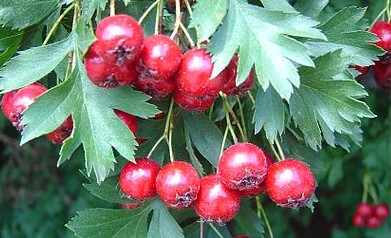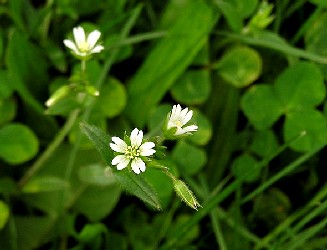
Fluxes/Diarrhea and Related Illnesses Page Menu: 1 2 3 4 5 6 7 8 9 10 11 Next>>
Treating Fluxes in the Golden Age of Piracy, Page 8
Treatment of a Flux: Internal Medicines - Astringents (Drying Medicines)
Pharmacopeia author James Rennie tells us that astringents were "employed to restrain profluvia, such as fluxes, hæmmorhages, gleet [a runny discharge], leucorrhœa, &c."1 Physician William Cockburn has much to say on the topic of the use of astringents in fluxes, perhaps because they were so popular in treating the problem. As he tells his readers, "Astringent Medicines are not only chiefly depended on, but promise something particularly, in the Practice of a Dysentery."2
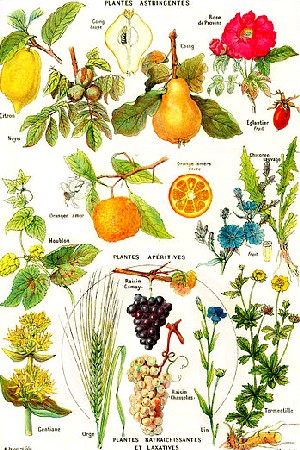
Astringent Plants, from Plantes astringentes et apéritives
by Galtier-Boissière (1912)
Cockburn's view on their use in a diarrhea are a little more involved. On the one hand, he explains that "astringent Medicines will, in some Measure, blunt the stimulating Parts, and thus prevent the Contraction of the Guts that was violent. And therefore, as astringent Medicines both blunt the stimulating Parts, and thicken the Stools, so they stop a Diarrhœa, and prove the Cure of it; as we find in Experience."3
However he also provides a rather extensive diatribe against their use in diarrheas.
Astringent Medicines are the common and last Resort of Physicians for the Cure of every Evacuation, but more especially for the Cure of every Loosness; both as they promise to restrain every extraordinary Discharge, as also, that Physicians believed the general Cause of a Loosness to be a preternatural Slipperiness of the Guts, which astringent Medicines might take off, and render the Guts harder, more rough, and less slippery. But as this Smoothness and Slipperiness of the Guts has not been found among the Causes of a Diarrhœa, and that the Notion is it self false and useless... astringent Medicines have been found to have done great Mischief on some Occasions, when they were made use of for the curing a Diarrhœa.4
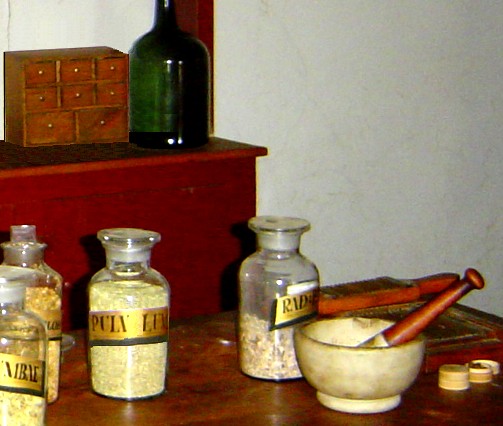
Lighting in the Cockpit, unknown artist (1820)
Cockburn later notes that astringents also don't eliminate dysenteries created by 'stimulating causes' which produce griping or pain in the stomach and intestines. He explains that most dysenteries are "produced by Simulating Causes, which are always attended with Griping. The only Use, then, of astringent Medicines, in the Cure of a Dysentery, is in paring a Stop to the Loss, and Effusion of Blood, after the Griping is overcome, if the Blood should continue so long."5
This discussion has something of a straw man argument to it. This is particularly relevant when you learn that Cockburn had created his own composition that he wanted to sell that would replace medicines such as astringents which were popular with many physicians and sea surgeons. (We will talk about Cockburn's Electuary in greater depth later.) The point here is that his argument against astringents may have been taken with a grain of salt by period sea surgeons if they recognized his ulterior motives.
Whatever his feelings about their effectiveness, Cockburn does give extensive coverage to various astringents throughout the course of his book. While discussing their use by others in curing diarrhea, he provides us with a nice list of simple (single ingredient) astringents for use in diarrheas:
Photo: Nadia Talent
"Haws" or Hawthorne Fruit - Crataegus Ambigua Medicines most generally commended, are red Roses, Plantain, Quinces, Pomegranates, Currants, Berberries, Myrtles, Mint, female Fern, Car duns Maria, Harefoot, Sumach, Lentils, Haws, Juice of Acacia (with us, of Sloes) the inner Rind of Oak, Cornel Berries, the Bark of the Service-Tree, Golden Rod, Shepherds-Pouch [Capsella bursa-pastoris], Bistort, Tormentil, Solomon's Seal, red Coral, Earth of Lemnos, Bole-Armoniack, and burnt Harts-horn. ... And afterwards [when the flux is gone], ripe Pears make Men go to Stool, but unripe Pears stop a Loosness. Again, wild Apples stay a Purging, but they purge when boiled and taken for Food.6
When he explains the use of astringents in Dysenteries, he gives us another extensive assortment of them [both simple and compound] as being recommended by other physicians for curing the problem.
Mouse Ear or Chickweed - aka Cerastium Vulgatum The Roots of Tormentil, Comfrey, Plantain, Water-Lillies, Sorrel, Mallow, Drop-wort and Pæony; which last is highly commended by Galen.Dioscordes extols the Leaves of Plantain, Knot-Grass [Polygonum], Cadweed, the Leaves of Willow-Herb, especially its Juice, given by way of a Clyster. Leaves of Oak are esteemed, as also Sanicle, Golden rod, common Winter-green, common creeping Mouse-ear, Agrimony, Tway-blade, Mountain Crowfoot, Cranes-bill, Periwincle, &c.
...
"Frankincense, Mastick, Nutmegs, Acorns, Beans, Earth from Lemnos, Bole Armoniack, Bloodstone, Saphir, Saffron, Hartshorn, Steel, Spa-waters, &c. are in the greatest Esteem among Physicians.7
Our golden age of piracy era surgeons and physicians do recommend many of these various astringent cures. In fact, we could spend several pages looking into each of the many ingredients in detail. However, it makes more sense to talk about the ones that appear several times in their manuscripts and those that are interesting and/or familiar. So we will restrict our coverage to Bole &Terra Sigillata [Earths], Citron-rinds, Hartshorn, Mastic, Nutmeg, Pears, Plantains, Quinces, Sloes and Snakeweed [Bistort] & Tormentil.
1 James Rennie, A New Supplement to the Pharmacopœpias of London, Edinburgh, Dublin and Paris, Baldwin and Cradock, p. 40; 2 William Cockburn, The Nature and Cure of Fluxes, p. 286; 3 Cockburn, p. 123; 4 Cockburn, p. 121; 5 Cockburn, p. 293; 5 Cockburn, p. 125-6; 5 Cockburn, p. 294-5
Treatment of a Flux: Internal Medicines - Astringents -- Bole or Terra Sigillata [Earth]
Bole and terra sigillata were both astringent forms of earth used in medicines during this time.
James Rennie tells us that bole are "earths, of which there are several species, and of which Bolus
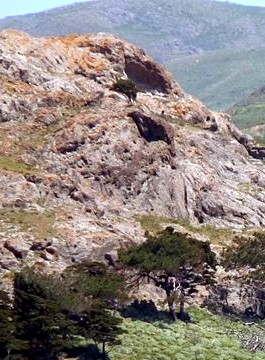
Photo: Michael Clark, Mountains of Lemnos
Arminiæ, P[owdered] Armenian bole, is the chief."1 Wikipedia provides a more descriptive explanation, noting that
Armenian bole "is an earthy clay, usually red, native to Armenia. It is red due to the presence of iron oxide; the clay also contains hydrous silicates of aluminum and possibly magnesium."2 When using bole in barley water, sea surgeon John Woodall notes that "the finer Bole [is powdered] the better"3.
Terra Sigillata is sometimes referred to as earth of Lemnos. This was a clay mined in Lemnos, Greece, where it was "shaped into tablets, or little cakes, and then distinctive seals were stamped into them, giving rise to its name terra sigillata - Latin for 'sealed earth'."4 The seal at this time featured the Ottoman sultan. In form, terra sigillata is "an aluminous earth of a grayish yellow color"5.
Both types of earth were considered astringent. Of bole, Rennie tells us, "It is astringent and dessicative [drying]"6. Physician Robert James explains that terra sigillata "is very astringent; whence it is recommended in Dysenteries, Diarrhœas, and other Kinds of Fluxes."7
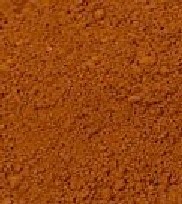
Modern Armenian Bole
Each of these forms of earth are included, often interchangeably, in various combinations that period surgeons recommended for treating a flux. Raymund Minderer combines bole with Mummia [ground up mummies - no, I am not making that up], mastic and dragon's blood [I am not making that up either, although here it refers to a plant-based red resin], to be taken "in a convenient Liquor, the weight of a dram, once or twice a day."8 He also suggests "the Seed of Dock, broad Plantain [plantago major]; items Terra Sigillata, or Bolus Armenus, and Wheaten-bread coming hot out of the oven, and dipt in red Wine, and eaten."9
John Woodall uses laudanum in combination with "Terra Sigallata, fine Bole, or with any other appropriate good medicine... [because the laudanum] is exceeding sure, for it fortifieth the other medicines, and doubleth their forces, adding his owne also thereto."10
1 James Rennie, A New Supplement to the Pharmacopœpias of London, Edinburgh, Dublin and Paris, Baldwin and Cradock, p. 54; 2 Armenian bole, wikipedia, gathered 3/12/13; 3 John Woodall, the surgions mate, p. 209; 4 Medicinal clay - Lemnian clay, wikipedia, gathered 3/12/13; 5 Terra sigillata, wikipedia, gathered 3/12/13; 6 Rennie, ibid.; 7 Robert James, Pharmacopœia universalis, p. 596; 8 Raymund Minderer, A Body of Military Medicines Experimented, Volume 4 of Paul Barbette's, Thesaurus Chirurgiæ, The Fourth Edition, p. 73; 9 Minderer, p. 71; 10 Woodall. p. 224
Treatment of a Flux: Internal Medicines - Astringents -- Citron-Rinds
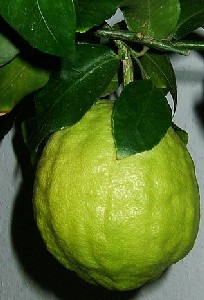
Photo: Ahoerstemeir, A Citron
Citron rinds are reputed to have several medicinal properties. Pharmacopeia author John Pechey tells us that the citron's "outward yellow Bark [the rind] hath a curious Aromatick Smell, and bitter Taste. Being dried, it is very Cordial [soothing], and Alexapharmick [resists poisons]. It heats and corraborates a cold and windy Stomach. It discusses Wind powerfully, concocting and digesting crude Humours that are contain'd in the Stomach or Bowels."1
Although he recommends it for removing the 'crude Humours' in the digestive system, he doesn't suggest that the citron rind has any astringent properties. His fellow period pharmacopeia author Nicholas Culpeper is silent on the topic.
However, sea surgeon John Woodall tells his reader that "Citron rindes, with other such like things are very commodious, because among naturall things I know nothing exsiccateth [exsiccates – dries up] more, and opposeth it selfe more against all corruptions."2
1 John Pechey, The Compleat Herbal of Physical Plants, p. 237; 2 John Woodall, the surgions mate, p. 207
Treatment of a Flux: Internal Medicines - Astringents -- Hartshorn

Photographer: Mehmet Karatay
"You want to do WHAT with my antlers?"
Hartshorn, or, as pharmacopeia author James Rennie suggests, "Stag's Horn Shavings"1 are also recommended in fluxes. Rennie explains that hartshorn is "emollient (soothing) and nutritive, but requires to have orange juice and sherry wine added, to cover its gluey flavour."2 Nicholas Culpeper's description of the rasped horn explains that it "resists Poyson [an anodyne], and the Pestilence [plague], provokes Urine, restores lost strength, brings forth both Birth and Afterbirth."3
None of this seems to imbue hartshorn with drying properties, and yet several period authors suggest using it. A more modern source reveals the reason it has been placed here. According to wikipedia, "Hartshorn jelly or a decoction of burnt hartshorn in water was used to treat diarrhea. The coal of hartshorn, called calcinated hartshorn, was used as an absorbent [drying medicine], as well as in the treatment of dysentery."4
In fact, charred is how sea surgeon John Woodall recommends it be used. He explains:
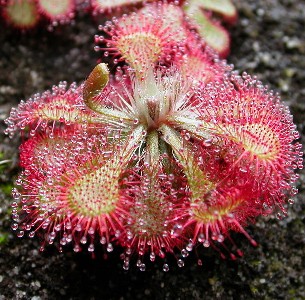
Photo: Denis Barthel
A Sundew, used to make Rosa folis
...I have cured many, both in Desenterie and Lyenterie, with burned Harts-horne, or in want thereof I have found that onely the hard bones of Beefe or Porke calcined or merely burned till they be white, for so they must be, and it may easily be done in any wood or coale-fire, being not a fire of sea-coale, and then being powdered fine, and given continually in the ordinary drinkes, during the time of the sicknesse it helpeth much, and you may assure your selfe, that if you take much or little of it, it can do no harme to be taken, and with some few drops of Cynamon water, if it may be had, it is the better, or a little Nutmeg and Cynamon in powder therein, also I have given it sometime with Rosa folis [a cordial water made from sundews (drosera)] and faire water [clean, pure water] mixed, of each two spoonfuls and {1 dram} of the powder of bones.4
Hartshorn is also popular used in compound medicines. Surgeon Raymund Minderer suggests that burnt hartshorn can be used to cure diarrheas by adding it to broath.5 Likewise, William Cockburn suggests that in "all the Kinds of a Loosness, the Sick drink the common Hartshorn Decoction, it being properly enough contrived, and being a Drink very agreeable to the Sick."6 It appears repeatedly in concoctions for many other illnesses suggesting that there must have been a thriving medicinal market for elks.
1 James Rennie, A New Supplement to the Pharmacopœpias of London, Edinburgh, Dublin and Paris, Baldwin and Cradock, p. 96; 2 Rennie, p. 97; 3 Nicholas Culpeper, Pharmacopœia Londinesis, p. 46; 4 Hartshorn, wikipedia, gathered 3/10/13; 4 John Woodall, the surgions mate, p. 212-3; 5 See Raymund Minderer, A Body of Military Medicines Experimented, Volume 4 of Paul Barbette's, Thesaurus Chirurgiæ, The Fourth Edition, p. 70; 6 William Cockburn, The Nature and Cure of Fluxes, p. 161
Treatment of a Flux: Internal Medicines - Astringents -- Mastic
Of the mastic tree or pistacia lentiscus, Nicholas Culpeper says that "Both the Leaves and bark of it stop Fluxes"1. Fellow period pharmacopeia author John Pechey does him one better, explaining that every part "of
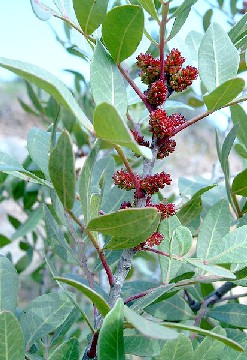
Mastic Tree Leaves and Fruit
it are binding; the Bud, the Leaves, the Branches, the Fruit, and the Bark and the Root. A Juice is pressed from the Leaves, boyl'd. Water, or from the green Leaves bruis'd; which taken inwardly, is good for Loosness, and the Bloody
Flux...
In short, Mastick is preferr'd before all other Medicines, in those diseases where there is need so Binding."2
While not quite as enthusiastic in their praise, our period surgeons do use it in their decoctions. For any flux, John Woodall advises Laudanum "taken with masticke, Terra Sigallata, fine Bole, or with any other appropriate good medicine, it is exceeding sure, for it fortifieth the other medicines, and doubleth their forces, adding his owne also thereto."3
Military surgeon Raymund Minderer suggests it repeatedly in various concoctions designed to cure a flux. In one cure he explains that "Mastick pulverised, and put into Almon-milk, red Wine, or Broath, the weight of a drachm, is good for such a Looseness especially as comes from indigestion; adding a little Nutmeg or Galingal to it."4 Minderer also adds mastic to a drink the patient is to use regularly, boiling it in water and combining it with other binding plants including "dried Sloes, dried slices of Quinces, burnt Harts-horn, ...Nutmeg, or any one of these; putting to it some of the roots of Snake-weed, Tormentil, or such like astringent roots."5 For the pièce de résistance, he puts it in the patient's food, advising the surgeon to use "Pigeon, Wood-cock, or Partridge, and having drawn any of them [removed the blood], fill them with Mastick and a little Nutmeg, and so rost them on a Spit"6.
1 Nicholas Culpeper, Pharmacopœia Londinesis, p. 30; 2 John Pechey, The Compleat Herbal of Physical Plants, p. 298-9; 3 John Woodall, the surgions mate, p. 224; 4 Raymund Minderer, A Body of Military Medicines Experimented, Volume 4 of Paul Barbette's, Thesaurus Chirurgiæ, The Fourth Edition, p. 71; 5 Minderer, p. 75; 5 Minderer, p. 74
Treatment of a Flux: Internal Medicines - Astringents -- Nutmeg
We have already seen several recipes that included Nutmeg (Myristica fragrans).1 Herbalist Nicolas
Culpeper offers rather weak praise for it, noting that "it is held to be the inward bark of Nutmeg-tree helps
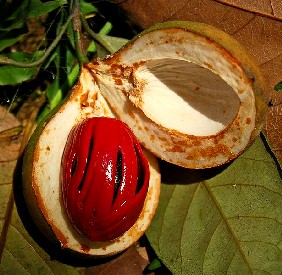
Photo: W.A. Djatmiko
A Fresh Nutmeg with Seed Exposed
fluxes"2. John Pechey starts off rather slowly by explaining that nutmeg "'tis somewhat Astringent, is Stomachick [agreeable to problems of the stomach]"3. He then goes on to give it quite a reputation.
Nutmeg is of great use in the Bloody-Flux, and other Fluxes; for it has all the Virtues necessary for a Medicine fit for these Diseases. The Oyly Substance of it defends the Guts from sharp Humours, and eases the Pain; the Aromatick Quality consisting in the Airy Spirit, penetrates the Noble Parts, and comforts them; the Earthy Part binds, dries up Ulcers, and Cicatrises them. ... [it] is very agreeable to the Stomach4.
Raymund Minderer begins his discussion on fluxes by revealing that nutmeg can cure them.5 In addition to his previously cited recipes, he gives another: "open a new-laid Egg, take out the white, and rill it up with Nutmeg, or the pulverised root of Tormentil, or of Snake-weed, and give it the Patient to eat; or put it into some pulverised Blood-stone, and it will do good."6 John Woodall also recommended it combined with hartshorn and/or dried beef and pork bones as noted previously.
1 For examples, see Raymund Minderer's medicinal recipes in the preceding section on Mastic; 2 Nicholas Culpeper, Pharmacopœia Londinesis, p. 15; 3 John Pechey, The Compleat Herbal of Physical Plants, p. 304; 4 Pechey, p. 304-5; 5 Raymund Minderer, A Body of Military Medicines Experimented, Volume 4 of Paul Barbette's, Thesaurus Chirurgiæ, The Fourth Edition, p. 70; 6 Minderer, p. 73
Treatment of a Flux: Internal Medicines - Astringents -- Pears
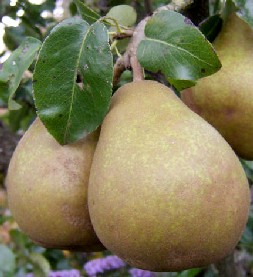
Photographer: Jonathan Billinger
Pears on the Tree
Pears were considered good for this purpose, as is suggested in the diagram of astringent plants that at the top of this page. Nicholas Culpeper says the pear is "grateful to the stomach, drying, and therefore helps fluxes."1 Fellow herbalist John Pechey agrees that they "are agreeable to the Stomach, and quench Thirst: But they are best baked. Dried Pears stop Fluxes of the Belly."2
While reviewing his list of ancient authors, physician William Cockburn cites Spanish author Franciscus Vallesius, who suggested "that white Wax put into the Middle of a Pear, and roasted with it, is an excellent Remedy for a Dysentery"3. Cockburn does not comment on the efficacy of this cure, nor does he recommend pears as a cure of dysentery when he gives his own views on the topic. In fact, none of our other period medical authors suggest them, possibly because fresh pears would be difficult to get at sea or in a military campaign. Dried pears are another matter, though. Perhaps they hadn't read Pechey's glowing praise for the fruit.
1 Nicholas Culpeper, Pharmacopœia Londinesis, p. 42; 2 John Pechey, The Compleat Herbal of Physical Plants, p. 144-5; 3 William Cockburn, The Nature and Cure of Fluxes, p. 299
Treatment of a Flux: Internal Medicines - Astringents -- Plantains
A lot of people think of a banana-like fruit when they hear the word plantain. While the fruit sort of
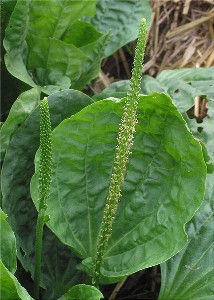
Photo: Rasbak
Plantane Major
plantain is indeed related to the banana, our period authors are talking about an herb. Pharmacopeia author James Rennie explains that the herbal version of the plantain includes "Plantago lanceolaia, P[ulverised], Ribwort, Plantago major, P[ulverised], Waybread and Plantago media, P[ulverised]"1 He says these are to be "used as feeble astringents and vulneraries [medicines to heal wounds]."2 However, Physician Robert James explains that the great plantain's "Root, Leaves, and Seed are used, which are heating, and drying, hepatic [used to heal the liver] and vulnerary, and are principally used in all sorts of Fluxes."3
Military surgeon Raymund Minderer says he has "used with good success the Seed of the broader Plantain, grossly beaten, and rosted in an Egg, against the Flux; and I know it also to have been beneficially used against the Bloody Flux."4
John Woodall agrees when there is a fever with a flux, advising the surgeon to "seeke to coole the bloud by a decoction of Plantane and colde hearbes or seedes if they be to be had or at sea with such medicines are used to quench heate, and are not meerely sharp, and yet oyle of Vitrioll is much commended to be taken certaine dayes together in any kinde of distilled waters either Plantane, Sorrell, Strawberies or the like, whilst the sayd waters are good and sweete"5.
;3 James Rennie, A New Supplement to the Pharmacopœpias of London, Edinburgh, Dublin and Paris, Baldwin and Cradock, p. 330; 2 Rennie, ibid.; 3 Robert James, Pharmacopœia universalis, p. 407; 4 Raymund Minderer, A Body of Military Medicines Experimented, Volume 4 of Paul Barbette's, Thesaurus Chirurgiæ, The Fourth Edition, p. 73; 5 John Woodall, the surgions mate, p. 209
Treatment of a Flux: Internal Medicines - Astringents -- Quinces
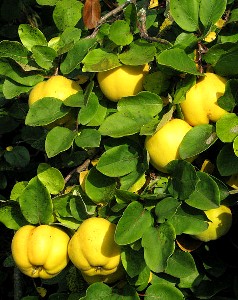
Photo: Dietrich Krieger
Quinces on the Tree Quinces were a popular fruit for treating fluxes. Herbalist John Pechey reveals that a quince is "very agreeable to the Stomach. 'Tis astringent, and cures Spitting of Blood, the Bloody-Flux, and all other Fluxes."1 Fellow Pharmacopeia author Robert James explains that the fruits are "stomachic, refrigerating, drying, and astringent. They are principally used in Vomiting, Fluxes, Hiccups, and Relaxations of the Stomach."2
One way to serve them is in the form of a jelly. James reveals that quince jelly or marmalade is "an Astringent, and is sometimes given in Diarrhœas and Dysenteries."3 Surgeon John Woodall advises giving 'conserve' of quinces "for for want of wine, beere or water" to heal the insides of the intestines4 and explains that "Marmalad of Quinces is also good" in a Lientery.5
Quince jelly is not the only form advised by period medical authors, however. Woodall suggests the use of syrup of quinces in cases of diarrhea.6 Military surgeon Raymund Minderer advises use of "an Electuary [a medicinal paste with sweeteners to hide the medicinal taste] made of Quinces
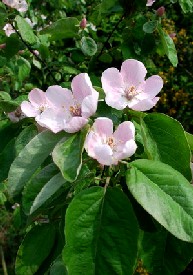
Photo: Alan Fryer, Quince Blossom
and Sloes" to cure fluxes and looseness."7
Minderer also suggests that "[t]he red Juyce of Quinces, boiled up without Sugar, is also much to be commended in this case [dysentery], for strengthening the bowels, two or three spoonfuls of it being taken at a time, and that twice a day."8 In addition, he advises that the patient drink a mixture prepared thus: "boil water, and in it Coriander, dried Sloes, dried slices of Quinces, burnt Harts-horn, Mastick, Nutmeg, or any one of these; putting to it some of the roots of Snake-weed, Tormentil, or such like astringent roots. Of this water the Patient may drink according as his necessity shall require."9
Almost as if in afterthought, Minderer adds, "The Rich may make Granat [pomegranate], or Quince-wine. But I have here undertaken to deliver such things, as are parable [?] and cheap for the poor common Souldier."10
I can't help but wonder what quince wine might taste like.
1 John Pechey, The Compleat Herbal of Physical Plants, p. 155; 2 Robert James, Pharmacopœia universalis, p. 306; 2 James, p. 706; 4 John Woodall, the surgions mate, p. 210; 5 Woodall, p. 203; 7 Raymund Minderer, A Body of Military Medicines Experimented, Volume 4 of Paul Barbette's, Thesaurus Chirurgiæ, The Fourth Edition, p. 70; 7 Minderer, p. 75; 8 Minderer, Ibid.; 9 Ibid; 10 Ibid..
Treatment of a Flux: Internal Medicines - Astringents -- Sloes
In the section on quinces, Raymund Minderer advised the use of an electuary "of Quinces and Sloes" to cure fluxes.2 He also used dried sloes in the drink he suggested be prepared for those ill of a flux.1 He also
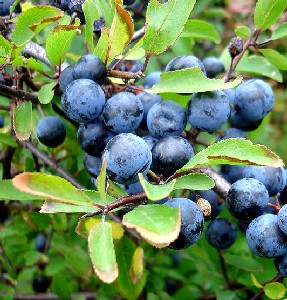
Photo: Martin Olsson, Sloes
In addition to drying, there are various ways to prepare sloes for medicinal use including a jelly. John Woodall appears to call for the juice of sloes in his book. He uses a Latin term, sanguis prunellorum, which roughly translates into 'the blood of sloes.'
William Cockburn lists 'acacia' among his list of simple astringents, which is yet another term for the juice of sloes.3 Physician Robert James explains that this is astringent and gives a recipe for the juice: "Take any Quantity of the Juice of unripe Sloes, and exhale it to a due Consistence, over a gentle fire."4 In a recipe provided by Nicholas Culpeper, he explains that the expressed juice should be made "thick in a bath"5 which is probably what 'exhaling to a due Consistence' means. Culpeper goes on to explain that the properties of this juice includes stopping fluxes and increasing appetite.6
Woodall uses the juice in several prescriptions. He leads off his list of astringing medicines by saying that "in the cure of Disentery, one very familiar and good Medicine is sanguis prunellorum aforesaid, the dose is {1 ounce} or (2 ounces} with Mint or Wormwood, or Carduus water, taken going to rest, or take of it selfe."7
1 See Raymund Minderer, A Body of Military Medicines Experimented, Volume 4 of Paul Barbette's, Thesaurus Chirurgiæ, The Fourth Edition, p. 75; 2 1 See Raymund Minderer, p. 70; 3 William Cockburn, The Nature and Cure of Fluxes, p. 126;4 Robert James, Pharmacopœia universalis, p. 706; 5 Nicholas Culpeper, Pharmacopœia Londinesis, p. 33; 6 Ibid.; 7 John Woodall, the surgions mate, p. 203
Treatment of a Flux: Internal Medicines - Astringents -- Snakeweed [Bistort] & Tormentil
"...the Roots of Tormentil, Snakeweed, or the Roots of Cinquefoil [a genus of 500 flowering plants that include tormentils], baked in Eggs, and eaten [cures fluxes and looseness]." (Raymund Minderer, A Body of Military Medicines Experimented, p. 70-1)
Minderer is the primary surgical source for using Snakeweed and Tormentil, often combining them. Physician William Cockburn puts them together as well in his list of simple astringent medicines for diarrheas1 and lists the 'Root of Tormentil' in his astringent cures for dysentery.2
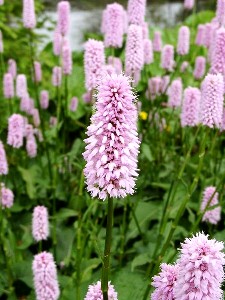
Photo: Ramin Nakisa
Snakeweed or Bistort (Persicaria bistorta)
Snakeweed is a bit of a misleading term. An on-line dictionary defines it as "Any of various plants, such as bistort, reputed to have the power to cure snakebite."3 Wikipedia sends you off to a sort of sunflower plant called Gutierrezia.4 However, our period herb and plant experts point us to the righ plant. Nicholas Culpeper, John Pechey and Robert James all refer to snakeweed as bistort in their entries.5
Among snakeweed's qualities, Pechey says it "cools and dries. The root of it is very astringent, harsh, alexipharmick [resists poison], and Sudorifick [causes sleep].... The Powder of the Root, mixed with Conserve of Roses, does wonderfully stop Spitting of Blood, and the Bloody Flux and other Fluxes."6 Robert James says the root is especially astringent "in Dysenteries, bloody Fluxes, [and] Dysenteric Exulcerations of the Intestines"7. Culpeper is similarly enthusiastic, stating that "taken inwardly, [it] resist Peftilence & poison, help Ruptures and Bruises, stay Fluxes, Vomiting and immoderate flowing of the term in Women, helps inflamation & soreness of the mouth, & fastens loose teeth, being bruised and boiled in white Wine, and the mouth washed with it."8 Quite the useful medicine, snakeweed!

Photo: Fornax, Tormentil Flower
Tormentil, or at least its root, is recognized by Pechey and James as being very useful in curing fluxes. Robert James reveals that its' root "is hard, knotty, crooked, and fibrous, of a reddish Colour and astringent Taste. It dries and astringes, and is therefore very good in all Fluxes"9. John Pechey explains that it "is very astringent; wherefore there
is no Remedy more proper for Fluxes of the Belly and Womb, than the Roots of Tormentil. Besides, they are Diaphoretick [causes sweating] and Alexipharmick"10. You may recall that period medical men found some uses for alexipharmics in treating fluxes. Curiously, Culpeper doesn't say anything about its use in flux, noting that it is dry "but moderately hot; exceeding good in Pestilences [the plague], provokes sweat, stayes Vomiting, cheers the Heart, expels Poyson."11
Minderer has nothing but good things to say about both of them."The Roots of Tormentil. or of Snake-weed pulverised, and this powder drunk in a convenient vehicle, the weight of a drachm, is one of the most approved remedies against these Fluxes; Tormentil-roots being very powerful not only to stop them, but also to take away their catching malignity.12
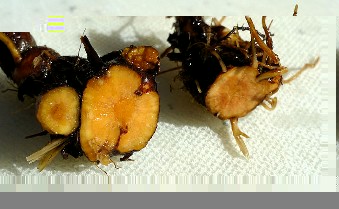
Photo: Wolfgang Frisch, Tormentil Root
Minder gives several recipes that use the roots of these two plants for fluxes. In addition to his egg filled with them in the above quote, he suggest using them in "the Patients ordinary drink"13, the recipe for which we saw when discussing Mastic and Quinces.
A rather curious concoction that Minderer gives us that includes tormentil is: "Scrape red Lead or Rudle, such as Carpenters mark their lines with, put it into Wine or Broath, wherein hath been boil'd the broader kind of Plantain and Tormentil-roots"14. In an even more outrageous-sounding prescription to cure a flux, he suggests that the surgeon procure "Rye-biscuit, and boil it in Water with Coriander, and the roots of Tormentil or of Cranes-bill [geraniums]; quench some Steel in it once or twice, and give of it to the Patient to drink."15 One drink of that would certainly have given the patient something to think about!
1 William Cockburn, The Nature and Cure of Fluxes, p. 126; 2 Cockburn, p. 293; 3 snakeweed. TheFreeDictionary.com, gathered 3/13/13;4 Gutierrezia, wikipedia.com, gathered 3/13/13; 5 Nicholas Culpeper, Pharmacopœia Londinesis, p. 3, John Pechey, The Compleat Herbal of Physical Plants, p. 21 and Robert James, Pharmacopœia universalis, p. 255; 6 Pechey, p. 21; 7 James, p. 255; 8 Culpeper, p. 3; 9 James, p. 459; 10 Pechey, p. 186-7; 8 Culpeper, p. 13; 12 Raymund Minderer, A Body of Military Medicines Experimented, Volume 4 of Paul Barbette's, Thesaurus Chirurgiæ, The Fourth Edition, p. 72-3;13 Minderer, p. 75; 14 Minderer, p. 73; 15 Minderer, Ibid.

